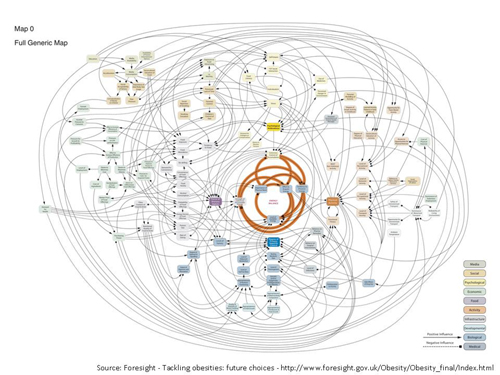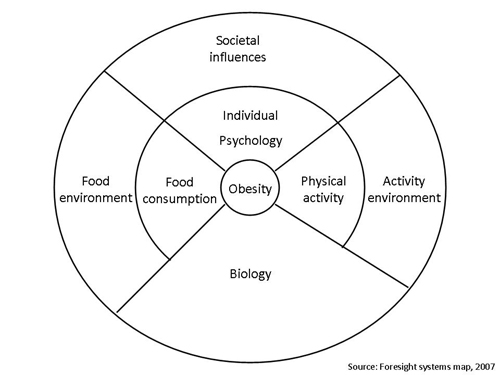Causes of obesity
Understanding the causes of obesity is critical to the success of prevention and treatment strategies. However, while (simply put) obesity occurs when energy intake from food and drink consumption is greater than energy expenditure through the body’s metabolism and physical activity over a prolonged period (resulting in the accumulation of excess body fat), in reality many complex behavioural and societal factors contribute systemically to the current crisis and no single influence dominates.

View full size >>
The Foresight report [2] refers to a “complex web of societal and biological factors that have, in recent decades, exposed our inherent human vulnerability to weight gain”, and presents an obesity system map (above) with energy balance at its centre and over 100 variables directly or indirectly influencing this energy balance; grouped in 7 cross-cutting themes (below):

- Biology: an individual's starting point - the influence of genetics and ill health;
- Activity environment: the influence of the environment on an individual’s activity behaviour, for example a decision to cycle to work may be influenced by road safety, air pollution or provision of a cycle shelter and showers;
- Physical Activity: the type, frequency and intensity of activities an individual carries out, such as cycling vigorously to work every day;
- Societal influences: the impact of society, for example the influence of the media, education, peer pressure or culture;
- Individual psychology: for example a person’s individual psychological drive for particular foods and consumption patterns, or physical activity patterns or preferences;
- Food environment: the influence of the food environment on an individual’s food choices, for example a decision to eat more fruit and vegetables may be influenced by the availability and quality of fruit and vegetables near home; and,
- Food consumption: the quality, quantity (portion sizes) and frequency (snacking patterns) of an individual’s diet.
The Government supports the Foresight view that while achieving and maintaining calorie balance is a consequence of individual decisions about diet and activity, our environment (and particularly the availability of calorie-rich food) now makes it much harder for individuals to maintain healthy lifestyles – and that it is for Government, local government and key partners to act to change the environment to support individuals in changing their behaviour.
Obesity takes time to develop and excess weight takes time to be lost. The risks of becoming obese may also start at an early stage. Growth patterns in the first few weeks and months of life affect the risk of later obesity and chronic disease. There is therefore a life-course component.
Tim Lang and Geof Rayner view the current obesity problem in the UK as the result of ‘societal, technical and ideological change' in the last half-century since the end of World War II and, while acknowledging that the present situation is partially a result of a culture in which highly calorific food is available at pocket money prices and technological advances that have made us a more sedentary nation, note also that:
‘the culture of clever and constant advertising flattering choice; the shift from meal-time eating to permanent grazing; the replacement of water by sugary soft drinks; [and] the rising influence of large commercial concerns framing what is available and what sells’ has powerfully contributed to the growing obesity problem.